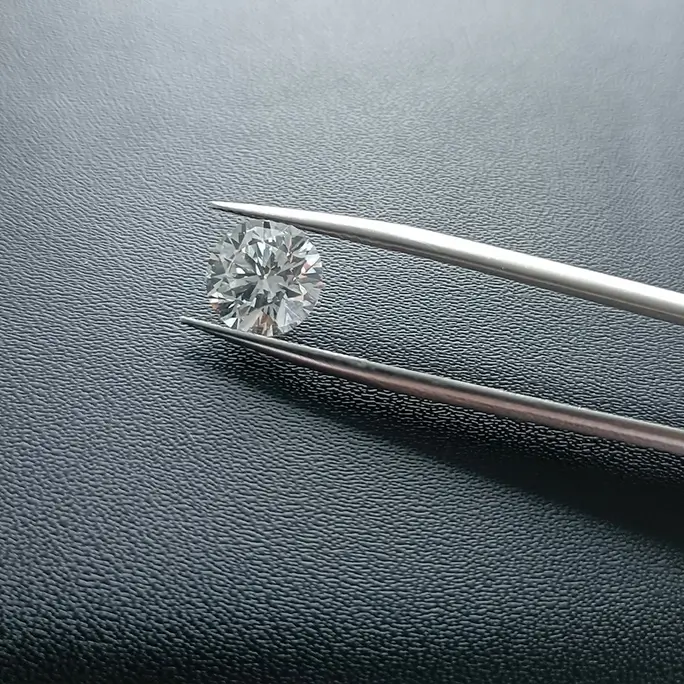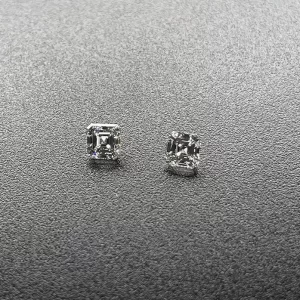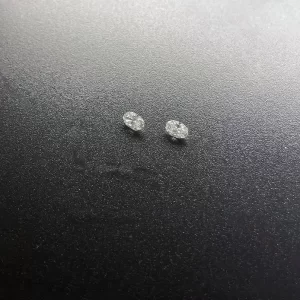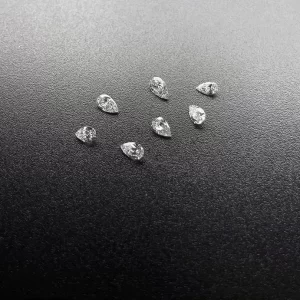Small Size Fancy Cut Lab Diamonds 10ct Round Brilliant White Color For Jewelry
Small Size Round Brilliant White Color Fancy Cut Lab Diamonds For Jewelry
Lab Grown Diamonds Description
In fact, lab-grown diamonds are also synthetic diamonds, which are currently grown artificially by high temperature, high pressure and meteorological precipitation. The growth idea is to use small diamonds as “seeds” to simulate the growth environment of natural diamonds through technical means, so that the carbon atoms in the “nutrients” gradually attach to the diamond seeds, so that the diamond seeds grow into larger diamond crystals.
There are now two ways to cultivate diamonds. The two kinds of diamonds produced are high temperature and high pressure diamonds and CVD diamonds.
Growing diamonds is a new technology. It is grown in a laboratory and has the same physical, chemical and optical properties as natural diamonds, so lab grown diamonds are also real diamonds. The price of a synthetic diamond is about a quarter of that of a natural diamond.
Characteristics Of Lab Grown Diamonds
(1)Beautiful sex.
By virtue of different light and various colors, the products of lab grown diamond processing provide novel and accessible choices among low-cost fashion accessories, which bring people an interesting wearing experience.
(2) Sustainability.
Lab-grown diamonds can be manufactured in unlimited quantities, and a 1-carat lab-grown diamond can be produced in a matter of days.
In contrast to natural diamonds, laboratory-made diamonds can be mass-produced.
Lightbox Diamonds – Colored Gems
The 4 C’s are the four aspects of beauty that combine to determine a diamond’s brilliance and beauty. The naked eye has difficulty discerning any single characteristic, but they all work together to create a diamond’s overall beauty. Round brilliant diamonds are the most popular cut, making up 60% of all diamonds sold and 75% of engagement rings. Despite these differences, round brilliant diamonds are still very popular among consumers.
Lightbox colored lab-grown diamonds
You may have heard of colored lab-grown diamonds, but did you know that Lightbox also produces pink and blue gems? Lightbox is a jewelry company that produces colored lab-grown diamonds in a number of different styles. If you’re interested in purchasing a gem, read on for information about Lightbox’s colored gems. It may surprise you to learn that these diamonds have a lot of different benefits.
Before a stone is cut, a technician from Lightbox analyzes its characteristics and decides how to process it. In some cases, a laser is used to remove the desired central portion, leaving the rest intact. A core is then created and used for further molding. The core is then cut into slivers and shaped into a finished gem. The remaining facets are then added and the diamond is polished.
The company guarantees its gems with a quality guarantee, and has set a standard price for the stones. The company’s quality assurance process is transparent, and each Lightbox lab-grown diamond is inscribed with a quality mark visible under a 10x loupe. The company also sells loose stones. If you’re interested in purchasing a colored lab-grown diamond, read on for more information.
Another notable benefit of buying Lightbox colored lab-grown diamonds for your jewelry is their affordable price. The gemstones are graded according to the same standards as mined diamonds, and come with a double-digit discount on their price. In September, the average price for a one-carat mined diamond was $8,900. As a result, Lightbox diamonds for jewelry are remarkably affordable, with prices as low as $800 per carat. Despite their high price, Lightbox diamonds are not in the same league as De Beers’ flagship gems.
The de Beers brand is the gold standard for diamonds. As one of the world’s largest diamond producers, De Beers is taking the lead in developing colored lab-grown diamonds for jewelry. Currently, the company has launched its Lightbox Finest line, which uses the CVD growth process to create stones that are VVS or IF clarity. Additionally, the “Lightbox Finest” line produces white diamonds with D, E, or F color, which are the highest color grades for white diamonds.
Radiant cut diamonds
A 1.03 carat radiant cut lab grown center stone is set in this ring. The stone is in the near colorless G color range and has VS1 clarity. The 14K white gold setting has a milgrain finish and is encrusted with pave diamonds. The ring’s style is classic and elegant, while retaining the quality of diamonds from the natural world. This piece would look stunning set on any woman’s finger.
The radiant cut diamond is the newest addition to the diamond scene, having been invented in the 1970s. Its 70-faceted design creates a brilliant sparkle while reflecting light. A square edging mimics the emerald cut and pays homage to the Art Deco movement. The result is a diamond with exceptional brilliance and an excellent price. But what makes it so special? Let’s take a look at the benefits of this style.
Another advantage of radiant cut lab diamonds for jewelry is the reduced wastage of rough diamond. In comparison to round diamonds, radiant diamonds make the best use of diamond rough. The radiant cut also tends to be deeper than other shapes, so they look smaller, despite their similar carat weight. The radiant cut is a very versatile cut for non-round diamonds. You can wear it with other shapes, too, such as a square or rectangular diamond.
When choosing a radiant cut diamond, make sure to check if it has a bow tie effect. This is a common characteristic of elongated radiant cut diamonds. It makes the stone appear ‘bow-tie’-like, making it an excellent option to hide inclusions. However, this feature does not lend itself to symmetry. The best way to check for this effect is by looking closely at the diamond in person.
The radiant cut is the sparkliest diamond on the market. It was first used in 1977. The radiant cut will give your engagement ring a unique look. Because they are 4% smaller than round diamonds, they have a smaller face-up size than round brilliant diamonds of the same carat weight. In addition, radiant diamonds can appear larger than round brilliant diamonds of the same carat weight. However, there is no guarantee that radiant cut diamonds will last forever.
Cushion cut diamonds
When shopping for cushion cut diamonds for jewelry, remember that their girdles are typically chunky and often irregular. In order to find a diamond that will look good in jewelry, the stone must be of high quality, a color grade of H, and a low clarity grade. The girdle of a cushion cut diamond should be large and eye clean. This shape is a good choice for engagement rings, necklaces, and earrings.
If you are buying a cushion cut diamond for jewelry, you should be aware that it is very difficult to find accurate information on the cut of this diamond. While this is the case for fancy cut diamonds, diamond grading reports do not provide information on the cut of cushion cut diamonds. If you’re unsure about the cut of your diamond, try comparing video images and ASET scope data to learn more about this beautiful shape.
While there are many styles and settings for this cut, it’s a classic shape that looks great with most designs. It is a versatile shape that can be worn with almost any style, from antique to modern, and complements most finger types. Because it is not so vulnerable to cracking or chipping, a cushion cut can be worn in jewelry with no protective settings. It’s also most impressive in a solitaire setting. These settings secure the diamond at its corners and make it look elegant. The ring can be a traditional solitaire or a band made of other materials.
There are many differences between the standard and modified cushion cuts. Standard cushion cuts feature fewer facets, while modified cushion cuts have more facets, producing an eye-catching star or glittering flower shape. However, both styles of cushion cuts can be used to create beautiful jewelry. So, if you want a perfect gemstone for your jewelry, it’s worth considering a cushion cut diamond for your jewelry. You’ll be pleased with the end result.
Because cushion cut diamonds can be expensive, it’s important to select a stone that is eye-clean and free of eye-visible imperfections. The best cushion cut diamonds are in the VS2 or SI1 clarity grade, but if you’re looking for a cheaper stone, consider looking for an I1 or S1 diamond instead. You’ll still find some cushion cut diamonds that look great in jewelry, but you won’t be able to tell the difference if they’re cut improperly.
Earth-created fancy color diamonds
If you’re shopping for a diamond ring, you’ll have many options. Earth-created fancy color diamonds are produced in the Earth’s mantle and are delivered to the surface by deep-source volcanic eruptions. These diamonds are colored due to foreign particles that interfere with the chemical process of diamond crystallization. Different kinds of colored diamonds have different causes. Yellow diamonds, for example, are colored due to nitrogen, blue diamonds are colored by boron, and black diamonds contain a large number of impurities.
The two types of diamonds are quite different in their origin and history. While Earth-created fancy color diamonds are more affordable, they don’t have the same high-quality qualities as their lab-grown counterparts. They’re also better for the environment and come from a far less resource-intensive process. While they’re far less expensive, lab-grown diamonds have a higher demand because they are made in a controlled laboratory rather than being mined in the rough.
Diamonds are naturally colored because they contain carbon atoms and other substances that change their color. They form deep below the Earth’s surface, under extremely high pressure and temperatures. The process of diamond formation is the same for all types of colored diamonds, but in some cases, foreign particles or other materials may interfere with the natural process. The result is a unique diamond that reflects green light instead of white light.
When buying a diamond, experts consider the intensity and rarity of the color. In addition to color saturation, the rarity and intensity of the diamond’s color also determine its value. Naturally colored diamonds lose their value as more color appears in the stone. Fancy Vivid and Intense diamonds are highly prized. But this doesn’t mean that fancy color diamonds are worthless. However, if you want to invest in a diamond ring, you’ll want to make sure you purchase one that is not only unique but has a high price.
The price difference between earth-created and lab-grown diamonds is minimal. Earth-created diamonds cost up to $600-$900, while lab-grown diamonds are priced around the same. The reason for the difference is supply and demand. For the same quality, both are worth the money. And you’ll get more bang for your buck with an Earth-created diamond. You’ll be pleased you did!
Small Size Fancy Cut Lab Diamonds 10ct Round Brilliant White Color For Jewelry


















